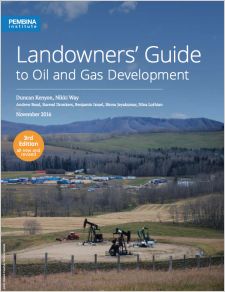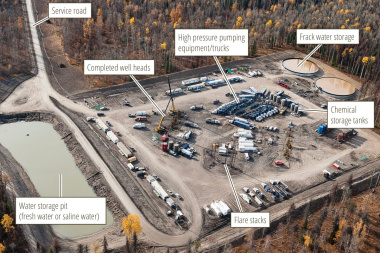Difference between revisions of "Alberta Landowners Guide, Hydraulic Fracturing"
m (1 revision imported) |
|
(No difference)
| |
Latest revision as of 17:21, 6 September 2020
 3rd edition | |
| Authors: | Duncan Kenyon, Nikki Way, Andrew Read, Barend Dronkers, Benjamin Israel, Binnu Jeyakumar, Nina Lothian |
|---|---|
| Publisher: | Pembina Institute |
| Publish Date: | October 2016 |
| PDF Download: | [Landowners' Guide] [Landowners' Primer] |
| Initiation Phase | |
| Exploration Phase | |
| Development Phase Overview of Oil and Gas Wells Before Drilling Questions About Lease Agreements Sour Oil and Gas and Emergency Response Hydraulic Fracturing Environmental Considerations of Hydraulic Fracturing | |
| Pipelines and Other Infrastructure | |
| Environmental Impacts | |
| Abandonment and Reclamation | |
| Compensation, Rights, and Hearings | |
| Appendices | |
Contents
About Hydraulic Fracturing
Some geological formations contain significant deposits of oil or gas trapped in shale rock and other types of geological formations (e.g. sandstone).[1] These formations cannot be produced with conventional drilling and production technology because the formations are very non-porous so the oil and gas does not “flow” to the surface like conventional oil and gas. These kinds of geological formations are generally described as “tight” or “shale” formations.
Hydraulic fracturing, which is a technological combination of fracturing and horizontal
drilling technology, has provided the technological solution to “cracking” the oil and
gas out of the formation. It is also informally known as “fracking”.
Conventional oil and gas reservoirs have driven Alberta’s historic oil and gas
production, but new conventional reservoirs are now very rare while existing production
is nearly depleted. However, there are still large formations containing shale gas and
tight oil that have not yet been put into production. As a result, hydraulic fracturing is
expected to dominate future oil and gas production in Alberta.
There are some significant differences between hydraulic fracturing and conventional
oil and gas drilling:
- greater number/density of well sites
- greater number of wells per well site
- larger volume of fluids to handle (truck traffic, increased risk of spills, etc)
- more noise from sites (compressor trucks)
- more air pollution (increased flaring, venting, diesel exhaust from compressor trucks and other transportation)
- larger, longer-lasting surface disturbances
Hydraulic fracturing operations use similar kinds of equipment as conventional operations, but there are some notable differences that increase the intensity of the operation and significantly increase traffic to and from the site during the fracturing operation.
Fracturing and well completion
In hydraulic fracturing, a mixture of water and other substances is injected below the surface into tight, resource-containing rock formations to fracture them and facilitate the flow of oil or gas for production. Combining this technique with horizontal drilling increases contact with the oil-producing rock layers, and has allowed substantially more oil or gas to be produced from tight reserves.
The fluid injected into the reservoir contains water, a number of chemical additives, and
a proppant. Proppant, typically sand, holds the fractures open and facilitate production.
The chemical additives serve a number of different purposes, including separating water
and oil, reducing fluid viscosity, reducing friction, managing pH, managing
temperature, killing bacteria, and preventing clay swelling. These additives typically
make up around 1% of the fracturing fluid.
| FracFocus (fracfocus.ca) is a chemical registry website that provides information on fracturing fluids. The information that the companies are required to report to the AER via Directive 059 is now posted to the FracFocus database. |
|---|
The fracturing fluid is injected in cycles to continually expand the fractures. After each
pressurization and subsequent fracture, the pressure is dropped and the injection fluids,
along with some reservoir fluids and gas, flow back to the surface. At the surface, efforts
are made to separate out these fluids from the gas and subsequently store the fluids on
the surface. Depending on the operator and location, these fluids are either reused in
subsequent fracturing stages or collected to be disposed.
The gas that flows to the surface at this stage must also be managed. Early in a new
development there is usually no infrastructure in place to capture and use the produced
gas. Without the infrastructure to capture the produced gas (which is primarily natural
gas but can include some fracture fluids, benzenes, and other hydrocarbons), it is
vented, flared or incinerated. Of the three options, incineration, when properly done,
provides a more complete combustion of the produced gases and generally minimizes
the air pollutants released.
Well and subsurface integrity
In conventional production, all efforts are made to maintain reservoir pressure well below the reservoir fracture pressure. However, this is the opposite in hydraulic fracturing, where the intention is to exceed the reservoir fracture pressure to break the rock layer and allow oil or gas to flow. These higher operating pressures mean that more care is needed to ensure that damage is not done to the wellbore that would release fluids at or below the surface or that the fractures do not propagate beyond the formation to contaminate other subsurface zones.
The Alberta Energy Regulator (AER) stipulates additional requirements for hydraulic
fracturing operations, in its Directive 083. To minimize this risk of wellbore damage, the
Alberta Energy Regulatory requires the use of either a dual- or single-barrier system to
isolate and contain fracture fluids in the event of a failure while also providing
detecting and responding to failures if they arise. Single-barrier systems present higher
risk and must be designed more carefully.
Fluids can also move through other existing wells drilled in the area (typically called
“offset wells”) to contaminate other areas or reach the surface, if a pathway between
wells is created during the fracturing process. To reduce this risk, the Alberta Energy
Regulator requires that all existing wells within the area be identified and assessed to
determine which may be at risk of being impacted by the operation. For each existing
well determined to be at risk, well control plans must be created and documented at the
fracturing operation to ensure that any movement of fluid is detected and responded to
accordingly. However, a significant challenge currently is that there are a large number
of very old existing wells that have never been identified or catalogued, making proper
identification and management of well to well transmission very difficult.
If you are aware of any existing wells in and around your lands, it is best to identify
them to the developer to ensure that they take the necessary precautions to maintain
well integrity.
Flowback fluid management
As noted above, the fracturing process occurs in cycles. After each pressurization and fracture, the pressure is dropped which allows the injection fluids and some reservoir fluids and gases to flow back up the wellbore and to the surface. These flowback fluids must be captured, contained, and disposed of to avoid surface contamination.
The cost of the fracturing fluid and the large volumes produced motivates reuse of these
injected fluids. The produced fluids are stored on site, where they can be separated and
processed for reinjection. Pits can be used to store the flowback fluid; however, due to
potential contamination from leaks and spills, above-ground storage tanks should be
used to minimize risk. Double-walled storage tanks provide the highest degree of
protection. Single-walled storage tanks can also be used, but must include a secondary
containment system such as a surrounding dike with impervious liner. AER Directive
055 outlines the technical storage requirements for the upstream oil and gas industry.[2]
The remaining fluid and drilling waste must be managed in the same manner as
conventional operations, as discussed in Well type and location.
Vehicle traffic
One of the most observable differences between traditional conventional production and hydraulic fracturing operations is the increased traffic to and from a hydraulic fracturing site. Due to the large volumes of water necessary for a fracturing operation, there is an associated increase in truck traffic to transport this water to the site and to remove the resultant wastes. This will increase traffic noise, congestion and dust in and around development areas during the fracturing process.
Some work is starting to be done to create water pipeline infrastructure that enables the
transport of water to the well site without tanker trucks. You and your neighbors should
ask the developer about their plans for water pipeline system as this can be a very
effective way to dramatically reduce one of the largest nuisances to landowners.
| Equitable Origins is producing a set of best management practices to ensure conformance with the EO100 Standard Provisions. The 2015 draft includes the following:[3]
|
|---|
References
- ↑ This material is from the Pembina Institute publication 'Landowners' Guide to Oil and Gas Development, 3rd edition (2016)'
https://www.pembina.org/pub/landowners - ↑ AER, Directive 055: Storage Requirements for the Upstream Petroleum Industry (2001).
- ↑ Equitable Origin, EO100TM Standard Technical Addendum: EO100.1: Shale Oil & Gas Operations (2015), 12. https://d2oc0ihd6a5bt.cloudfront.net/wp-content/uploads/sites/1738/2016/05/EO100-for-Shale-Oil-and-Gas_DRAFT_v2.pdf
| ||||||||||||||||||||||||||||||||||||||||||||

